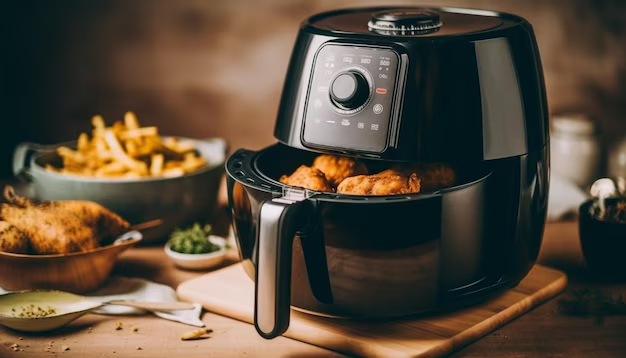Air Fryers the Magic of Healthy and Crispy food
Air fryers the magic of healthy and crispy food
Add Your Heading Text Here
An air fryer is a appliance used in kitchen for cooking food. It’s a unique style of cooking, circulating hot air around it, with the effect of deep frying but with significantly less oil. It uses a fan and a heating element to create a crispy exterior while keeping the interior moist. Air fryers are popular for making healthier versions of fried foods, such as French fries, chicken wings, and vegetables, with less fat and fewer calories compared to traditional frying methods. They often come with adjustable temperature settings and timers for convenient cooking.

How it Workds
Air fryers works in the process of convection cooking. They have a heating element and a fan that circulates hot air at high speed, cooking the food evenly from all sides. The result is a crispy exterior while retaining moisture inside. Most air fryers come with adjustable temperature settings and timers, allowing for precise cooking.
Popular Uses
- Fried Foods: Fries, chicken wings, and onion rings can be made with less oil while still achieving a satisfying crunch.
- Roasting: Vegetables can be roasted quickly, enhancing their natural flavors.
- Baking: Items like muffins, cookies, and even small cakes can be baked in an air fryer.
- Reheating: It’s also great for reheating leftovers, as it helps retain moisture and prevents sogginess.
Pros of Air Fryers
- Healthier Cooking: Air fryers use significantly less oil compared to traditional frying methods, making fried foods lower in calories and fat.
- Crispy Texture: They produce a crispy exterior on foods, mimicking the texture of deep-fried items without the added grease.
- Quick Cooking Times: Air fryers generally cook food faster than conventional ovens due to rapid air circulation, making them convenient for busy schedules.
- Versatility: They can be used to cook a variety of foods, including vegetables, meats, baked goods, and frozen snacks, expanding your cooking options.
- Easy Cleanup: Most air fryers have dishwasher-safe parts, making cleanup quick and easy compared to traditional frying methods.
- Compact Size: Air fryers are typically smaller than conventional ovens, making them suitable for kitchens with limited counter space.
- Less Odor and Mess: Cooking with an air fryer usually results in less odor and splattering, keeping the kitchen cleaner.
Cons of Air Fryers
- Limited Capacity: Air fryers often have smaller cooking capacities, which may require cooking in batches for larger families or gatherings.
- Texture Differences: While they create a crispy exterior, the texture may not be identical to deep-fried foods, which some users may find less satisfying.
- Learning Curve: Adapting recipes designed for traditional frying can require experimentation, as cooking times and temperatures may vary.
- Price: High-quality air fryers can be relatively expensive compared to other cooking appliances, which may be a consideration for budget-conscious consumers.
- Noise Level: Some air fryers can be noisy due to the fan operation, which might be bothersome in quiet environments.
- Space Considerations: While they are compact, air fryers can still take up valuable counter space, especially in smaller kitchens.
- Durability: Some users report that air fryers may have a shorter lifespan compared to traditional ovens or other kitchen appliances.
Difference between Air fryer and Oven
Both air fryers and ovens have their strengths and can be valuable tools in the kitchen. Air fryers are excellent for quick, crispy meals with less oil, while ovens provide larger cooking capacities and versatility for a wider range of dishes. Choosing between the two depends on your cooking habits, preferences, and the types of meals you frequently prepare. Many people find that having both appliances offers the most flexibility in their cooking routines. Here’s a comparison of the both.

Cooking Method
- Air Fryer: Uses convection cooking, where a heating element and a powerful fan circulate hot air rapidly around the food. This creates a crispy outer layer, mimicking the texture of fried foods with little or no oil.
- Oven: Typically uses either conventional heating (where heat comes from elements at the top and bottom) or convection (where a fan circulates hot air, similar to an air fryer). Ovens are generally less intense in airflow compared to air fryers.
Cooking Time
- Air Fryer: Cooks food faster due to the high-speed air circulation, often reducing cooking times by 20-30% compared to traditional ovens.
- Oven: Generally takes longer to preheat and cook food, especially for larger items or dishes that require more space.
Size and Capacity
- Air Fryer: Usually smaller and more compact, making them ideal for countertop use. They are suited for cooking smaller batches of food, which can be a limitation for larger families or gatherings.
- Oven: Typically has a larger cooking capacity, allowing for multiple dishes or larger items to be cooked simultaneously, such as casseroles or roasts.
Texture and Results
- Air Fryer: Produces a crispier texture on foods, similar to frying, which is desirable for certain items like fries and chicken wings.
- Oven: While convection ovens can also create a crispy exterior, traditional baking in an oven may not achieve the same level of crispiness without using more oil or specialized techniques.
Versatility
- Air Fryer: Best for frying, roasting, and reheating, and can also bake small items. However, they might not be as effective for large roasts or baking large cakes.
- Oven: More versatile for a wide range of cooking methods, including baking, roasting, broiling, and dehydrating. They can handle a variety of dishes and sizes.
